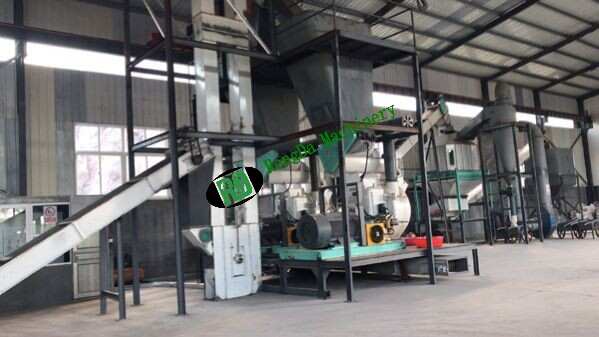Welcome to Rongda Machinery Co., Ltd
Toggle Navigation
In the pursuit of sustainable energy, wood pellet mills have emerged as a groundbreaking technology, enabling the production of a renewable, efficient, and environmentally friendly energy source. With global energy demands increasing and a growing focus on reducing carbon footprints, many are turning to wood pellets as a cleaner alternative to fossil fuels. In this article, we’ll take a closer look at what a wood pellet mill is, how it works, and the numerous benefits it brings to both consumers and industries.

A wood pellet mill (also referred to as a pellet press) is a machine designed to compress biomass materials, such as wood shavings, sawdust, and agricultural by-products, into small cylindrical pellets. These pellets are compact, easy to handle, store, and burn, making them an efficient energy source.
The operation of a wood pellet mill follows a series of key steps:
Raw Material Preparation: The first step involves gathering the raw materials. These materials are then cleaned to remove impurities like dirt and stones. For optimal pelletizing, the materials are finely ground into uniform particles.
Moisture Control: Moisture content is a critical factor in pellet production. The raw biomass is adjusted to an ideal moisture level (typically between 10-15%) to ensure proper pelletizing. If the moisture is too high, the material is dried using rotary or flash dryers.
Pelletizing: Once the biomass is ready, it’s fed into the pellet mill. Inside, high pressure and temperature are applied, forcing the biomass through a die that contains many small holes. As the material is compressed, it forms pellets, which are then cut into uniform lengths.
Cooling: Freshly produced pellets are hot and need to cool down. Cooling systems help lower their temperature, allowing them to harden for easier storage and handling.
Packaging: Once the pellets are cooled, they’re ready for packaging. They can either be sold in bulk or bagged for retail, making them accessible to residential consumers, businesses, and industries alike.
The growing popularity of wood pellet mills can be attributed to the numerous benefits of wood pellets themselves. Let’s explore some key advantages:
1. Renewable Energy Source:
Wood pellets are made from renewable resources, primarily wood waste and biomass by-products. This makes them a sustainable energy option that significantly reduces carbon emissions when compared to fossil fuels.
2. Efficient Energy Production:
Wood pellets have a high energy density, meaning they can produce a large amount of heat and power. This makes them an efficient option for home heating, industrial processes, and even electricity generation.
3. Cost-Effectiveness:
As fossil fuel prices rise, wood pellets offer a more affordable energy solution. The abundance of raw materials and improvements in pellet mill technology contribute to the decreasing cost of production, making them an attractive alternative for various energy needs.
4. Versatility:
Wood pellets are incredibly versatile. They’re widely used for residential heating through pellet stoves and boilers but are also employed in industrial boilers, power plants, and even cooking in some regions.
5. Easy Storage and Transport:
Pellets are compact, uniform, and easy to store in smaller spaces. Their consistent size also makes them easier to transport, lowering logistical and shipping costs.
Wood pellet mills play a vital role in producing energy and other products across various sectors:
1. Residential Heating:
Pellet stoves and boilers are growing in popularity among homeowners seeking cost-effective and efficient heating solutions. These systems offer cleaner combustion and produce fewer emissions than traditional heating methods.
2. Industrial Energy Production:
Many industries use wood pellets as fuel for boilers to generate steam for manufacturing processes. This shift reduces reliance on fossil fuels, supporting greener industrial operations.
3. Power Generation:
Some power plants have started using wood pellets to co-fire with coal. This helps reduce their carbon footprint while maintaining the ability to generate electricity, contributing to a greener energy mix.
4. Animal Bedding:
Wood pellets are also utilized as an eco-friendly bedding material for livestock. Not only are they absorbent and odor-reducing, but they can also be composted after use, offering farmers a sustainable option for managing animal waste.
In summary, a wood pellet mill is a crucial piece of technology in the production of wood pellets, a sustainable and renewable energy source with a broad range of applications. Whether for heating homes, fueling industries, or generating electricity, wood pellets are rapidly becoming a staple in reducing dependence on non-renewable energy sources.
As the global demand for renewable energy continues to rise, wood pellet mills present an excellent opportunity for entrepreneurs, businesses, and even homeowners interested in entering the green energy market. With their high energy density, affordability, and versatility, wood pellets are poised to play a significant role in shaping the future of sustainable energy.
Whether you're a homeowner seeking a greener way to heat your home or a business aiming to reduce its carbon footprint, the time to consider wood pellets is now. By exploring the potential of this renewable resource and the technology that drives it, you can be part of a more sustainable future.